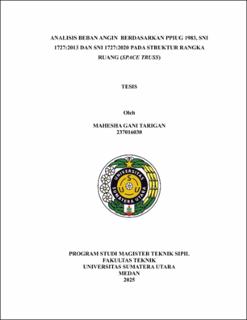Analisis Beban Angin Berdasarkan PPIUG 1983, SNI 1727:2013 dan SNI 1727:2020 pada Struktur Rangka Ruang (Space Truss)
Wind Load Analysis Based on PPIUG 1983, SNI 1727:2013 and SNI 1727:2020 on Space Truss Structures

Date
2025Author
Tarigan, Mahesha Gani
Advisor(s)
Tarigan, Johannes
Nursyamsi
Metadata
Show full item recordAbstract
In structural design, loading is a fundamental aspect that determines the internal forces acting on structural elements. In Indonesia, wind load regulations have evolved from PPIUG 1983 to SNI 1727:2013 and SNI 1727:2020, driven by increased building complexity, improved meteorological data, and stricter safety requirements. This study aims to compare the effects of these three standards on wind load distribution for space truss structures. The analysis is conducted on a large-span space truss using ETABS software. Several key parameters are examined, including wind pressure at various locations (¼ span windward, ½ span, and ¼ span leeward), horizontal and vertical displacements, axial forces in tension and compression members, base plate reactions, and overall structural tonnage. The results indicate significant differences in wind pressure values and structural responses across the standards. SNI 1727:2020 introduces a new coefficient (Ke) for surface elevation in the wind pressure formula, which is not present in earlier versions. Additionally, changes in building categories and exposure classifications influence the resulting wind loads. For example, the maximum wind pressure for SNI 1727:2020 at ½ span reaches -0,878 kN/m², higher than the -0,832 kN/m² dan PPIUG 1983 -0,55 kN/m² found in SNI 1727:2013. Variations are also evident in displacement values and member forces.
Collections
- Master Theses [278]
